Barbara Anne Waite's Blog
July 24, 2021
The Colour Box
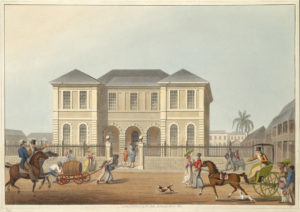
My colorful life in Antigua- How sad I feel when I think of all that blind people miss in observing a world filled WITHOUT color. I have a favorite color, blue. In Antigua blue surrounded me- the sky was an ever changing shade of blue, afternoon blue skies mixed with reds and orange and pink in glorious displays of sunset colors. But blue I discovered was also a favorite color to paint houses. In many neighborhoods in my current country colors are regulated- even down to the shade of white. Oh, the bright turquoise wooden houses often with colorful shutters of another tone. Looking down on an Antigua village as our plane descended, I enjoyed observing the vibrant display of roof colors as well. Of course, the blues of the Caribbean Sea changed hourly as the clouds passed over or the sea churned with a storm. In California I had grown up with a year round display of flowers, but I discovered in Antigua greens in the crotons that changed even within the same plant. I seem to remember that James Michener’s book The Caribbean began with a description of crotons. Each flower in my garden was a feast for the eyes. Then there were birds and shells that demonstrated the master of artists – God.
The island’s fish were another clear example of God’s creative hand in adding a riot of colors. When snorkeling the florescent colors of coral and sea fans became another feast for the eye gate.
People were also wonderfully diverse and colorful. Skin shades were as colorful and as varied as the plants and flowers. When we would periodically return to the USA “white” people seemed to look almost ill they could be so pale.
There were other ways my life in Antigua was colorful, through sounds. Though sometimes confused by expressions and accents people used I enjoyed hearing people banter. Once I recorded a conversation I overheard because I was fascinated by it, though I could not understand the local dialect. An Antiguan friend then explained I had a recorded a “curse fight.” OOPS. And the children walking down the street at Christmas with their iron band, creating music from anything metal gave me a thrill. Of course, the “pans” (percussion instruments made from 55 gal. steel drums) remain a favorite – whenever I hear one now it brings tears to my eyes. I can vividly remember the first time I heard a steel band playing a distance away. I wondered how an entire orchestra could be on a beach. I adored the sound of tree frogs at night – unless one of those tiny creatures decided to interrupt my slumber by parking on my windowsill. For a number of our years in Antigua we lived in the country and the sound of cattle and donkeys was a welcome change from freeway or traffic noise.
Our first week in Antigua I vividly remember a woman walking past with a tray balanced on her head selling bananas. She did not just walk past she called out in a distinctive and rather delightful voice, “Ripe fig- Ripe Fig”- I soon learned bananas were referred to as figs, and avocados were called pears.
But perhaps my favorite colorful vocal memory is the dear petite and elderly woman who walked the streets selling the local newspaper literally singing, “The Workers Voice is calling you, hello- hello- it calling you – The Workers Voice, The Workers Voice.” I once asked her if I could record her singing and selling. She agreed if I would first buy her an ice cream- which I gladly did.
We lived in a village house during our nearly forty years spent on the island of Antigua; attending a small local church pastored by a West Indian Pastor. Most of my friends and acquaintances were folks from the islands, Dominica, St. Vincent, Montserrat, Dominican Republic, as well as Antigua. What a rich colorful time those years were for my family, and that influenced me to write of the colorful beginnings of Antigua’s schools. Many of my favorite memories of sights and sounds crept into “The Colour Box.”
April 8, 2021
The Colour Box
Thanks to all who have purchased The Colour Box and special thanks for those who reviewed.
Here are a couple recent reviews:
Into the history of Antigua in the slave days step the Hart sisters. How does one own another human being? The Colour Box is indeed colourful. Barbara Anne Waite paints pictures with her words. Having been in Antigua for many years before, I know the places she mentions. I smell the ducana. I see the paintbox of colours in the foliage and the people. So many beautiful shades! And the story is precious and keenly sensitive dealing with the issue of race. We see the grief of Anne and Elizabeth as their father inherited as a free black a plantation and owning slaves that he did not ask for. The answer? Love and education and faith. So many scenes are sweet- Barry Hart, their father, dancing with Annie when they learn that the Declaration of Independence in the US declares all men equal. Will it come to Antigua and how? How will plantation life end? Barbara Waite has delved into the history of those days and basic facts- a Sunday school to educate and teach, as education is the key to ending the injustice. I love this book. One can see, sense, smell, experience the Caribbean and the rich history of the beautiful people that live there
Just finished reading “The Colour Box” and was completely charmed. This historical novel is based on the lives of two free bi-racial sisters on the island of Antigua in the 1700 and 1800’s. They were educated and extraordinary, using their talent and knowledge to teach many plantation slaves to read and write. There is a beautiful love story in this book for both the sisters who married later in life and whose husbands joined in and encouraged their activities. Teaching and reaching out to the less fortunate continued throughout their lives. A beautiful timely and captivating read that is both entertaining and educational.
Available on Amazon :https://www.amazon.com/Colour-Box-Bar...
February 25, 2021
The Colour Box- New Novel will be on Amazon March 15
I am pleased to announce the new historical novel based on the lives of two sisters who lived on Antigua in 1800s will soon be available. Watch for it on : BarbaraWaiteBooks.com
I remember as a child enjoying those work sheets in school where dots with numbers or letters were connected to reveal a picture of a flower, a tree etc. As a child I enjoyed discovering what picture the dots would reveal.
While in New Jersey a year ago we visited a museum that connected some of the links of Elsie’s Gilman family history for me, and I felt rather like a dot to dot picture was disclosed.
When the Revolutionary War ended, the United States spent nearly a decade without a regular navy. With the war against Great Britain won, the reasoning went, why would it need a navy? The simple answer is: pirates.
After breaking with England, 1783, the American War for Independence officially ended. Thus, American merchant ships no longer were protected by the Royal Navy. The fledgling U.S. government couldn’t raise a Navy but believed it could stave off attacks from Barbary pirates — north African privateers from Algiers, Morocco, Tunis, and Tripoli by paying the tributes demanded by pirates.
While the Moroccan pirates cooperated, the Algerian leader declared war on the United States, capturing a merchant ship in 1784.
Without a protecting force American trade to the Mediterranean would always be insecure. Desperate to utilize the Mediterranean trade route and protect American ships, the 1794 Congress, at George Washington’s urging, authorized a fleet of six U.S. Navy ships.
In the current novel I am writing I slipped in an imaginary connection between the Hart sisters of Antigua and my Grandmother Elsie’s grandmother, Malvina Amanda Gilman born in 1810 in Alexandria, Va.
Her father, Ephraim Gilman, was born in Gilmantown, N.H. in 1778. Twenty -seven year old Ephraim married 18 year old Anne Crawford in 1805, the same year Elizabeth Hart married Charles Thwaites in Antigua.
Ephaim was a merchant that owned ships which sailed to foreign parts. I assume he sailed to the Caribbean because my tattered family history papers say he brought back cotton and molasses, both grown in Antigua. Ephaim became prosperous merchant. In the war of 1812 the British burned his warehouse and schooner of flour.
The Gilman family came to America on the good ship Diligent in 1638 due to religious persecution in England. The census ledger of 1810 records that Ephraim imported Moroccan shoes. When I read about the beginning of our US Navy in the maritime museum in Philadelphia, I realized how the dots connected.
By 1801, the pirates of Tripoli had launched a full-on campaign against the U.S. that would later be referred to as the First Barbary War. The1805 victory for the U.S. Navy would mark the first win.
The Second Barbary War launched in 1812 —was the same year that the United States began warring once more with Great Britain. With its resources spread thin, the U.S. government tabled any efforts to confront Algiers or its pirates.
It wasn’t until 1814, ending the United States’ last skirmish with England, that the Navy was able to set its sights on Algiers — and an end to Barbary piracy once and for all. Congress officially declared war on Algiers March 3, 1815, after growing the U.S. Navy for three years. Ephraim died in Washington, D.C. in 1853. Thus the creation of the US Navy allowed him quite a few years to secure his fortunes as a shipping merchant.
It was fun to slip a Gilman relative into the story of the Harts sisters in Antigua.
My new website for the book is found at www.BarbaraWaiteBooks.com
September 14, 2018
HOOKED ON RESEARCH
I remember a few years back there was a children’s program called “Hooked on Phonics.” I suppose I could write my own program called “Hooked on Research.” I have often thought that if my life had followed a different path that I could have thrived as a research librarian. I love books. I love old books with gorgeous covers. I own some books that I have never read, but would not part with because I am fascinated by their vintage covers. Some I have read over and over, and they are tattered friends that flood me with memories of visits to second-hand bookshops in downtown San Diego with Elsie. We rode the bus and wandered thru old buildings filled with books. I was nine when she bought me Louisa May Alcott’s “Eight Cousins” and the poetry collection “Silver Pennies.”
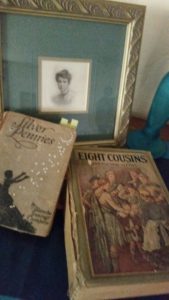
Two treasured books Elsie gave me in 1956.
I think she would be thrilled to know I have discovered a passion for historical research. She might be surprised that my first two books dealt with her story, and perhaps excited I am writing a historical novel about the country we called home for 38 years.
Research about life in Antigua (during the years 1740-1834) comes from numerous sources. I sit at my computer near an old undated map of Antigua. It lists towns, churches, and forts. If I look with a magnifying glass, I can see that Sir William Codrington had six windmills on his estate.
When our children were young, my husband used to take them on adventures that included the sugar mills that were still standing in the early 1980’s. They documented on 3 x 5 notecards the name of the mill, date if they could find it, and the type of stone used. Those windmills have withstood over 200 years of hurricanes. Fun to think our children started my research nearly 40 years ago as they trudged thru thorn bushes and fought off yellowjackets that built nests in those reminders of sugar mill and slavery years.
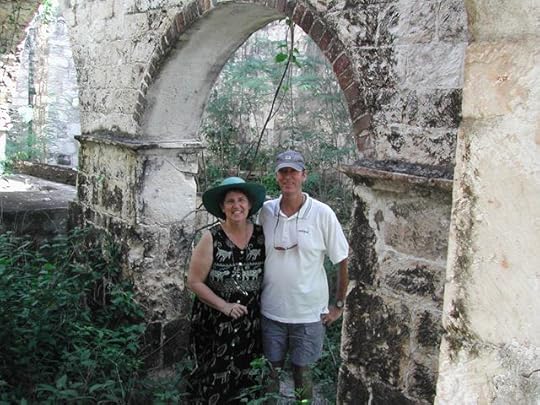
Barb & Curt exploring the ruins at Betty’s Hope Plantation
Long before I ever dreamed of writing a book based on historical Antigua I was fascinated by the courthouse built hundreds of years ago and which remains a museum today. Nelson’s Dockyard, the site of the British Naval buildings constructed nearly 250 years ago, serves as a witness to the days Britain fought with the French for the possession of the Caribbean islands. I began collecting books about the Naval Dockyard in the 1970’s.
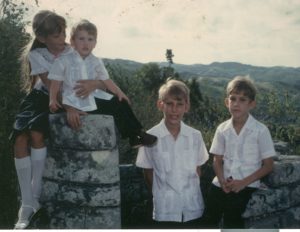
1984- Carin, Joshua, Dan and Christopher at Fort George overlooking English Harbour
These days I find myself reading thru Antiguan wills dating from the 1780’s, newspaper snippets from the same time period and even diaries of American women who lived on plantations in places like Georgia or South Carolina. Research and imagination link together in my mind to bring history to life.
July 30, 2018
Elsie’s Gilman Connection
30 July
I have always enjoyed looking at profiles of faces. When my siblings and I divided my mother’s estate some years ago, my first choice of furniture or keepsakes was a relief profile of Ephraim Gilman. I seem to remember that my mother never had it hanging in my childhood home. She stored it in a closet, but the story behind the face fascinated me as a child. My grandmother Elsie frequently reminded me that this was the face of her great-grandfather. It was carved from a piece of wood by Ephraim’s younger brother, Zadok, and given to Ephraim on his wedding day, June 20, 1805. Ephraim married Anne Crawford (age 18) in Alexandria, Virginia. They had seven children that lived and six that died in infancy. Their second daughter, Malvina Amanda Gilman, born in 1810, was Elsie’s Grandmother.
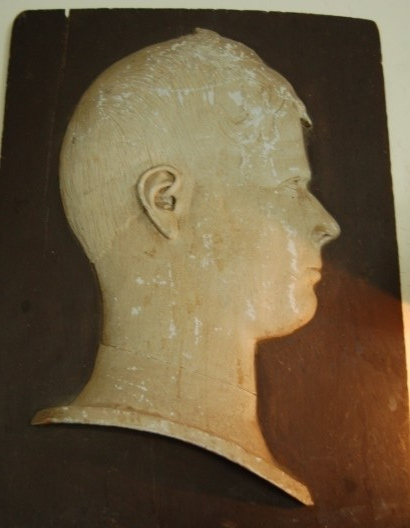
Ephraim Gilman carved by brother Zadok
Thursday was Ephraim’s birthday; He was born July 12, 1778, 240 years ago. His family came to America on the good ship Diligent in 1638 due to religious persecution in England. Ephraim’s grandfather Johnathan Gilman was a captain in the War of Independence and was killed in action at age 63 in 1776.
Ephraim became a prosperous merchant in Alexandria. One of the ledgers records that he imported Moroccan shoes. It also stated he sailed his ships to foreign places to bring back molasses.
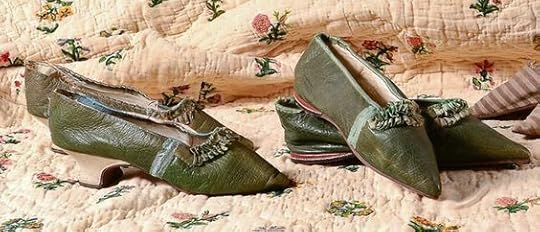
Moroccan shoes of 1800
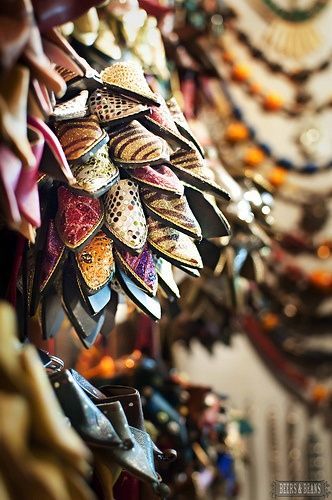
Moroccan shoes
I spent 38 years smelling molasses in Antigua, a by-product of the production of Antiguan Rum. Someday I want to read his ledgers from 1808-1820 preserved on microfilm in the Alexandria Library. I imagine all sorts of adventures hidden in those ledgers. During the war of 1812, the British burned Ephraim’s warehouse and a schooner of flour.
These paintings of the Gilmans were the work of a young artist, Cephas Thompson. Cephas eventually became well known. He captures Anne’s young beauty and a handsome Ephraim. I do not own the paintings. But, the profile carved and gifted from one brother to another is mine.
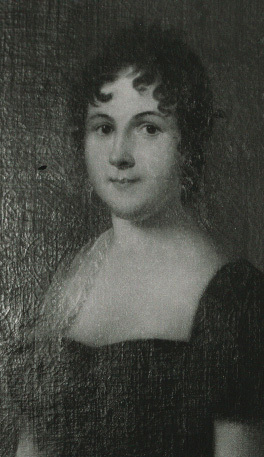
Anne Crawford Gilman – painted by Cephas Thompson about 1808
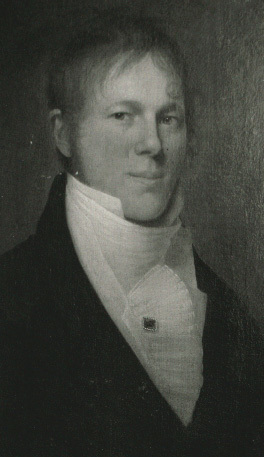
Elsie’s great-grandfather Ephraim Gilman
I am grateful for an invitation to speak to the daughters of the American Revolution in Valley Center on February 14th at 10 a.m. in the Valley Center Library. I enjoy sharing history. I have relatives from at least three branches that fought in the Revolutionary War. My son Joshua has researched at least 14 relatives that came to America before 1640.
My goal now is to include an imaginary link in my next book between the Hart sisters of Antigua and Ephraim Gilman’s wife, Anne Crawford. They lived during the same time-period. Elizabeth Hart was married the same year Ephraim and Anne Crawford were married.
July 26, 2018
Elsie’s Gilman Connection
I have always enjoyed looking at profiles of faces. When my siblings and I divided my mother’s estate some years ago, my first choice of furniture or keepsakes was a relief profile of Ephraim Gilman. I seem to remember that my mother never had it hanging in my childhood home. She stored it in a closet, but the story behind the face fascinated me as a child. My grandmother Elsie frequently reminded me that this was the face of her great-grandfather. It was carved from a piece of wood by Ephraim’s younger brother, Zadok, and given to Ephraim on his wedding day, June 20, 1805. Ephraim married Anne Crawford (age 18) in Alexandria, Virginia. They had seven children that lived and six that died in infancy. Their second daughter, Malvina Amanda Gilman, born in 1810, was Elsie’s Grandmother.

Ephraim Gilman carved by brother Zadok
Thursday was Ephraim’s birthday; He was born July 12, 1778, 240 years ago. His family came to America on the good ship Diligent in 1638 due to religious persecution in England. Ephraim’s grandfather Johnathan Gilman was a captain in the war of Independence and was killed in action at age 63 in 1776.
Ephraim became a prosperous merchant in Alexandria. One of the ledgers records that he imported Moroccan shoes. It also stated he sailed his ships to foreign places to bring back molasses.

Moroccan shoes of 1800

Moroccan shoes
I spent 38 years smelling molasses in Antigua, a by-product of the production of Antiguan Rum. Someday I want to read his ledgers from 1808-1820 preserved on microfilm in the Alexandria Library. I imagine all sorts of adventures hidden in those ledgers. During the war of 1812, the British burned Ephraim’s warehouse and a schooner of flour.
These paintings of the Gilmans were the work of a young artist, Cephas Thompson. Cephas eventually became well known. He captures Anne’s young beauty and a handsome Ephraim. I do not own the paintings. But, the profile carved and gifted from one brother to another is mine.

Anne Crawford Gilman – painted by Cephas Thompson about 1808

Elsie’s great-grandfather Ephraim Gilman
I am grateful for an invitation to speak to the daughters of the American Revolution in Valley Center on February 14th at 10 a.m. in the Valley Center Library. I enjoy sharing history. I have relatives from at least three branches that fought in the Revolutionary War. My son Joshua has researched at least 14 relatives that came to America before 1640.
My goal now is to include an imaginary link in my next book between the Hart sisters and Ephraim Gilman’s wife, Anne Crawford. They lived during the same time-period. Elizabeth Hart was married the same year Ephraim and Anne Crawford were married.
July 16, 2018
Elsie’s Family History
I have always enjoyed looking at profiles of faces. When my siblings and I divided my mother’s estate some years ago, my first choice of furniture or keepsakes was a relief profile of Ephraim Gilman. I seem to remember that my mother never had it hanging in my childhood home. She stored it in a closet, but the story behind the face fascinated me as a child. My grandmother Elsie frequently reminded me that this was the face of her great-grandfather. It was carved from a piece of wood by Ephraim’s younger brother, Zadok, and given to Ephraim on his wedding day, June 20, 1805. Ephraim married Anne Crawford (age 18) in Alexandria, Virginia. They had seven children that lived and six that died in infancy. Their second daughter, Malvina Amanda Gilman, born in 1810, was Elsie’s Grandmother.

Ephraim Gilman carved by brother Zadok
Thursday was Ephraim’s birthday; He was born July 12, 1778, 240 years ago. His family came to America on the good ship Diligent in 1638 due to religious persecution in England. Ephraim’s grandfather Johnathan Gilman was a captain in the war of Independence and was killed in action at age 63 in 1776.
Ephraim became a prosperous merchant in Alexandria. One of the ledgers records that he imported Moroccan shoes. It also stated he sailed his ships to foreign places to bring back molasses.

Moroccan shoes of 1800

Moroccan shoes
I spent 38 years smelling molasses in Antigua, a by-product of the production of Antiguan Rum. Someday I want to read his ledgers from 1808-1820 preserved on microfilm in the Alexandria Library. I imagine all sorts of adventures hidden in those ledgers. During the war of 1812, the British burned Ephraim’s warehouse and a schooner of flour.
These paintings of the Gilmans were the work of a young artist, Cephas Thompson. Cephas eventually became well known. He captures Anne’s young beauty and a handsome Ephraim. I do not own the paintings. But, the profile carved and gifted from one brother to another is mine.

Anne Crawford Gilman – painted by Cephas Thompson about 1808

Elsie’s great-grandfather Ephraim Gilman
I am grateful for an invitation to speak to the daughters of the American Revolution in Valley Center on February 14th at 10 a.m. in the Valley Center Library. I enjoy sharing history. I have relatives from at least three branches that fought in the Revolutionary War. My son Joshua has researched at least 14 relatives that came to America before 1640.
My goal now is to include an imaginary link in my next book between the Hart sisters and Ephraim Gilman’s wife, Anne Crawford. They lived during the same time-period. Elizabeth Hart was married the same year Ephraim and Anne Crawford were married.
February 14, 2018
A Valentine Memory of Arizona Statehood
Feb.14th 2018- Arizona celebrates its 106th birthday today. Happy Valentines Day. I shared in the book a Valentine remembrance Elsie loved to tell about. She received a special Valentine while teaching in Arizona that was chocolate covered soap. Her laughter when telling this story filled the room with her effervescent joy. She had a chuckle that was like none other I have ever heard. It seemed to come from her toes and traveled all the way to her heart, and out her mouth filling the room with mirth.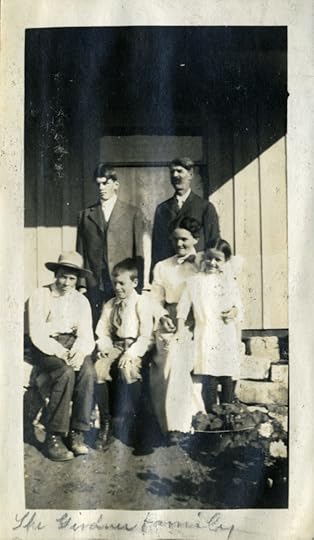
The Girdner Family 1913
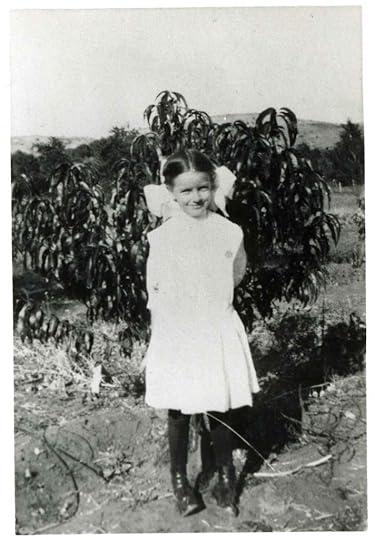
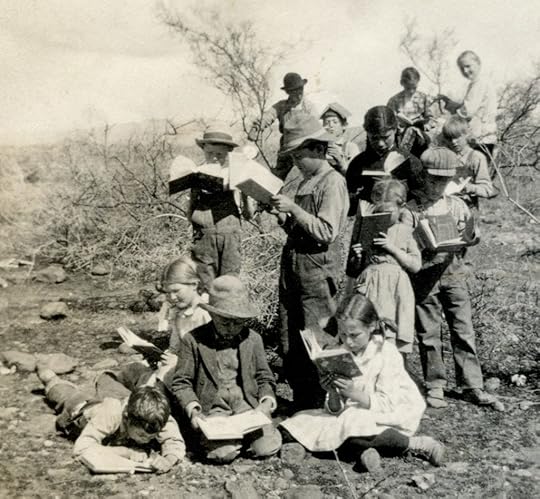
I had the privilege to meet Eva in 1989, she was charming. In the book, I share about Eva Girdner’s memory of the first Arizona statehood celebration that occurred in Oak Creek Canyon. She shared that there were about 25 families living along the beautiful lower Oak Creek. When word arrived that statehood had been granted the Arizona territory the news was passed to all the families along the creek to meet for a picnic. The children celebrated with foot and burro races. Eva’s mother made her a unique red, white and blue dress for the occasion. I wonder which child had the privilege to ride his burro shouting the news of statehood and announcing the celebratory picnic. Somehow it seems that an e-mail or telephone call would never be as exciting as watching a child arriving breathless with the news that the territory was now the State of Arizona! I think “Elsie” would be a great movie. Much of what she wrote creates a vivid picture in my mind.
I keep thinking how Elsie would be delighted knowing that her story received 332 reviews on Amazon and has sold over 1,200 copies just in the Tuzigoot and Montezuma’s Castle National Parks.
Special thanks to all who have added a review or clicked the like button on Elsie’s Amazon page. I think those reviews really encourage others to buy the book. I am grateful and thrilled to have recently shared her story with The Daughters of The American Revolution here in San Diego.
July 14, 2017
The Joy of Having Relatives who Preserved History
Elsie was certainly too genteel to be labeled a hoarder. She was a keeper of bits of history. I am thankful for the bits of history I inherited from her. Her cedar chest contained a treasure secured years ago, a Civil War Brain teaser game. Perhaps there is a better name for it, but that was the label my daughter Carin came up with. It consists of 24 heavy-duty card stock cards that have great illustrations drawn with pen and ink. There was a sheet included with the answers. I wonder if it was possibly given to my great-grandfather when he was injured as a child during the Civil War? That is a fascinating story found in the second Elsie book, “Elsie’s Mountain.” Alonzo became injured when Union soldiers mistakenly fired cannons at what they assumed was an abandoned farmhouse located about where the Pentagon stands today. The farmhouse actually was Alonzo’s family home. After Alonzo Hayes was wounded they took him to the Union surgeon to sew up his wound. Elsie said her father limped all his life, as a result of that injury. I can imagine a soldier telling the young Alonzo to be brave and he’d give him a game. See if you can guess what some of the answers are, I will include answers after the pictures.Some answers were unreadable.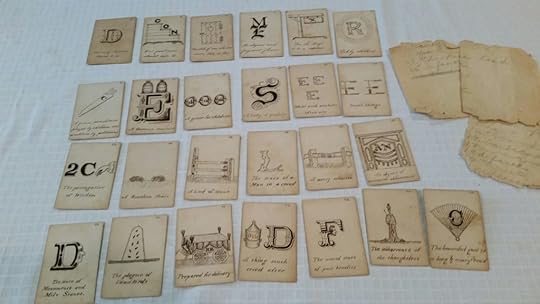
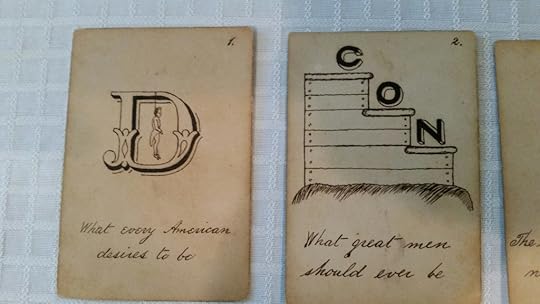
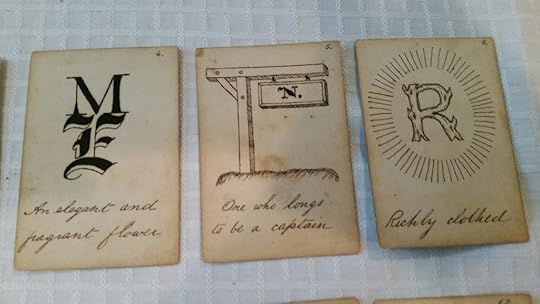
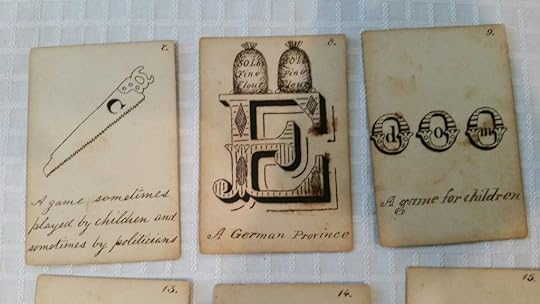
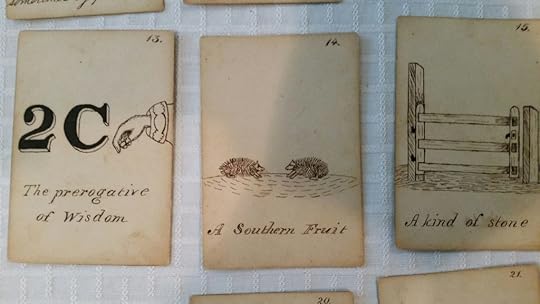
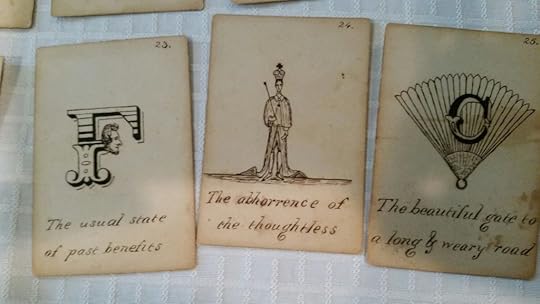
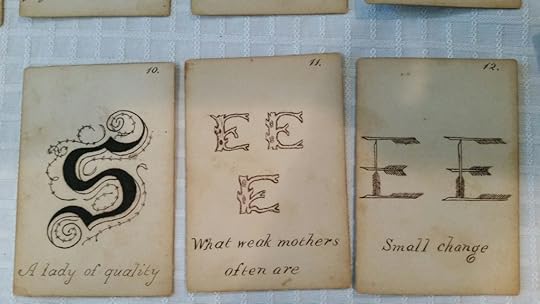
1. Independence
2. Condescending
7. Seesaw
8. Saxsony
9. Dominoes
10.Duchess
11. Easy
12. Pennies
14. Prickley Pear
16. Elbowed
17. barbeque
18. An ingrate
19. Defaced
22. Candy
20. Tenants
24. thinking
25. infancy
January 17, 2017
Dead Men Tell Tales
Nearly 50 years have passed since I first discovered I was attracted to old cemeteries. Driving down a dirt road on our way to a retreat in N. C., I spied gravestones nestled among the pines and oaks and we stopped to investigate. I loved the overwhelming sense of connecting with the past – with hidden history. Not just bodies rested beneath the earth, but the stories connected with those lives.
Years later, I read aloud several of Eugenia Price’s historical books as we experienced long road trips with our four children. Her books led to a quest to visit the graveyard on St Simon’s Island, Georgia. We took a memorable drive to see that fascinating graveyard and charming old church which she described.
I became hooked on old cemeteries. On the island of Antigua, we uncovered hidden grave stones at the site of Bridgetown and created rubbings from some of the large flat memorials that laid buried under dirt and debris. Our footsteps have since walked among many aging headstones in a number of states, and in several countries.
This Christmas we spent a delightful time in Malaysia with our daughter and her family. I keep trying to single out a favorite day from our trip. Perhaps the memory that shines best is the quiet Sunday afternoon spent in Georgetown, wandering among some of the 500 graves in the Old Protestant Cemetery, established in 1786. These people no longer have a voice, but history oozes from the earth and hangs dripping from the trees and vines that surround the large, ornate tombstones. We strolled around reading names and dates, soaked in the serenity – contemplating our own mortality. The tombstones there in Penang represented governors, lawyers, merchants, army personnel. Most people in the 1800’s in Malaysia failed to achieve age fifty. Many died as children or only survived to their twenties. 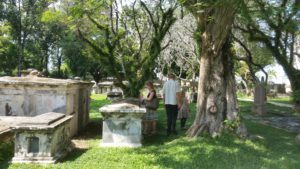
Old Protestant Cemetery -Penang
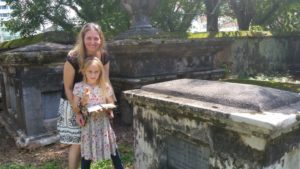
Carin, beside Thomas Leonowens tomb
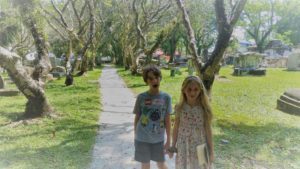
Like Hansel and Gretel following a trail
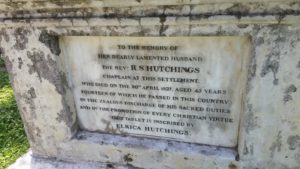
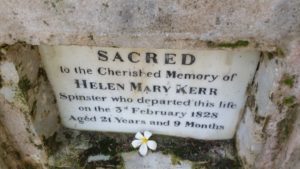
When only age nine, I delighted in the movie “The King and I.” I did not realize then that real people had been the basis for that story. There in Georgetown we stood by the grave of Anna’s husband, Thomas Leonowens. He died at age thirty-one. Anna, born in India in 1831, was a mere twenty-eight when he died. Needing employment, she traveled to Singapore with her two children and established herself as an educator for the children of British officers. Three years later, she accepted an offer to teach the thirty-nine wives and eighty-two children of the King of Siam. Hollywood portrayed her story (based on her journals), with a good deal of historical license. I stood there in Malaysia, by Leonowens tomb, wondering about the life of this hotel-keeper who died in 1859, thankful his gutsy wife recorded her memories from Siam. I mused what Hollywood might do to Elsie’s story were it (pipe dream) to be made into a movie!
On our return from Asia, jet-lag and the flu forced me to wrap in a blanket, with tea and a marvelous new book , “The Mark of the King” by Jocelyn Green. This exciting historical fiction based on an 18th century French colony in Louisiana assisted my recovery. Thanks, Jocelyn for the delightful diversion from Kleenex and cough syrup. Her research uncovered a story I found fascinating; her writing wrapped me in another era.
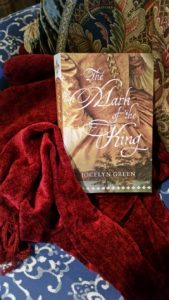
Available on Amazon- New Book by Jocelyn Green- ” The Mark of the King”
Now I am back at work researching and writing historical fiction about Antigua in the late 1700’s. Thanks, Carin, for the moments we squeezed in to consult on this work-in-progress. Thanks for warm memories and delightful days spent with you in Malaysia.
On January 22, to celebrate Elsie’s 129th birthday, her story “Elsie’s Mountain” will be free, that day only, on Amazon as an e-book. So, if you have not yet read the sequel to Elsie’s Arizona story, here is a one day opportunity to grab it for free. I am thrilled that after four years her Arizona story is still selling and has 329 Amazon reviews. Thanks, friends.



